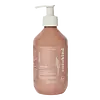What's inside
What's inside
 Key Ingredients
Key Ingredients

No key ingredients
 Benefits
Benefits

 Concerns
Concerns

 Ingredients Side-by-side
Ingredients Side-by-side

Water
Skin ConditioningGlycerin
HumectantCaprylic/Capric Triglyceride
MaskingCetearyl Olivate
Butyrospermum Parkii Butter
Skin ConditioningSorbitan Olivate
EmulsifyingSimmondsia Chinensis Seed Oil
EmollientDicaprylyl Carbonate
EmollientCaprylhydroxamic Acid
Glyceryl Caprylate
EmollientPanax Ginseng Extract
AntioxidantTremella Fuciformis Extract
HumectantSchisandra Chinensis Fruit Extract
Skin ConditioningCentella Asiatica Extract
CleansingSaccharomyces Ferment
Skin ConditioningGlyceryl Stearate
EmollientInulin
Skin ConditioningFructose
HumectantXanthan Gum
EmulsifyingNephelium Lappaceum Leaf Extract
Skin ConditioningTocopherol
AntioxidantNiacinamide
SmoothingCamellia Sinensis Leaf Powder
ExfoliatingCetearyl Alcohol
EmollientBrassica Oleracea Capitata Leaf Extract
Skin ConditioningCurcuma Longa Root Extract
MaskingCaffeine
Skin ConditioningLactobacillus Ferment Lysate
Skin ConditioningPentylene Glycol
Skin ConditioningEthylhexylglycerin
Skin ConditioningWater, Glycerin, Caprylic/Capric Triglyceride, Cetearyl Olivate, Butyrospermum Parkii Butter, Sorbitan Olivate, Simmondsia Chinensis Seed Oil, Dicaprylyl Carbonate, Caprylhydroxamic Acid, Glyceryl Caprylate, Panax Ginseng Extract, Tremella Fuciformis Extract, Schisandra Chinensis Fruit Extract, Centella Asiatica Extract, Saccharomyces Ferment, Glyceryl Stearate, Inulin, Fructose, Xanthan Gum, Nephelium Lappaceum Leaf Extract, Tocopherol, Niacinamide, Camellia Sinensis Leaf Powder, Cetearyl Alcohol, Brassica Oleracea Capitata Leaf Extract, Curcuma Longa Root Extract, Caffeine, Lactobacillus Ferment Lysate, Pentylene Glycol, Ethylhexylglycerin
Water
Skin ConditioningGlycerin
HumectantCocos Nucifera Oil
MaskingCetearyl Alcohol
EmollientHelianthus Annuus Seed Oil
EmollientButyrospermum Parkii Butter
Skin ConditioningCetearyl Glucoside
EmulsifyingAspergillus/Rice Ferment Extract
HumectantPersea Gratissima Oil
Skin ConditioningStearic Acid
CleansingCaprylhydroxamic Acid
Ethylhexylglycerin
Skin ConditioningGlyceryl Caprylate
EmollientPolyacrylate Crosspolymer-6
Emulsion StabilisingSodium Phytate
Sodium Stearoyl Glutamate
CleansingMaltodextrin
AbsorbentWater, Glycerin, Cocos Nucifera Oil, Cetearyl Alcohol, Helianthus Annuus Seed Oil, Butyrospermum Parkii Butter, Cetearyl Glucoside, Aspergillus/Rice Ferment Extract, Persea Gratissima Oil, Stearic Acid, Caprylhydroxamic Acid, Ethylhexylglycerin, Glyceryl Caprylate, Polyacrylate Crosspolymer-6, Sodium Phytate, Sodium Stearoyl Glutamate, Maltodextrin
Ingredients Explained
These ingredients are found in both products.
Ingredients higher up in an ingredient list are typically present in a larger amount.
This ingredient is also known as shea butter. It is an effective skin hydrator and emollient.
Emollients help soothe and soften your skin. It does this by creating a protective film on your skin. This barrier helps trap moisture and keeps your skin hydrated. Emollients may be effective at treating dry or itchy skin.
Shea butter is rich in antioxidants. Antioxidants help fight free-radicals, or molecules that may harm the body. It is also full of fatty acids including stearic acid and linoleic acid. These acids help replenish the skin and keep skin moisturized.
While Shea Butter has an SPF rating of about 3-4, it is not a sunscreen replacement.
Shea butter may not be fungal acne safe. We recommend speaking with a professional if you have any concerns.
Learn more about Butyrospermum Parkii ButterCaprylhydroxamic Acid is a chelating agent.
Chelating agents help prevent metal ions from binding to other ingredients. This helps prevent unwanted reactions and effects from using the product.
Caprylhydroxamic Acid is often used with natural antimicrobial products as an alternative to preservatives.
Learn more about Caprylhydroxamic AcidCetearyl alcohol is a mixture of two fatty alcohols: cetyl alcohol and stearyl alcohol. It is mainly used as an emulsifier. Emulsifiers help prevent the separation of oils and products. Due to its composition, it can also be used to thicken a product or help create foam.
Cetearyl alcohol is an emollient. Emollients help soothe and hydrate the skin by trapping moisture.
Studies show Cetearyl alcohol is non-toxic and non-irritating. The FDA allows products labeled "alcohol-free" to have fatty alcohols.
This ingredient is usually derived from plant oils such as palm, vegetable, or coconut oils. There is debate on whether this ingredient will cause acne.
Due to the fatty acid base, this ingredient may not be Malassezia folliculitis safe.
Learn more about Cetearyl AlcoholEthylhexylglycerin (we can't pronounce this either) is commonly used as a preservative and skin softener. It is derived from glyceryl.
You might see Ethylhexylglycerin often paired with other preservatives such as phenoxyethanol. Ethylhexylglycerin has been found to increase the effectiveness of these other preservatives.
Glycerin is already naturally found in your skin. It helps moisturize and protect your skin.
A study from 2016 found glycerin to be more effective as a humectant than AHAs and hyaluronic acid.
As a humectant, it helps the skin stay hydrated by pulling moisture to your skin. The low molecular weight of glycerin allows it to pull moisture into the deeper layers of your skin.
Hydrated skin improves your skin barrier; Your skin barrier helps protect against irritants and bacteria.
Glycerin has also been found to have antimicrobial and antiviral properties. Due to these properties, glycerin is often used in wound and burn treatments.
In cosmetics, glycerin is usually derived from plants such as soybean or palm. However, it can also be sourced from animals, such as tallow or animal fat.
This ingredient is organic, colorless, odorless, and non-toxic.
Glycerin is the name for this ingredient in American English. British English uses Glycerol/Glycerine.
Learn more about GlycerinGlyceryl Caprylate comes from glycerin and caprylic acid, a fatty acid from coconut. It has emollient and emulsifier properties.
As an emollient, it helps hydrate your skin. Emollients work by creating a barrier on your skin to trap moisture in, helping to keep your skin soft and smooth.
On the other hand, emulsifiers prevent ingredients (such as oil and water) from separating.
Learn more about Glyceryl CaprylateWater. It's the most common cosmetic ingredient of all. You'll usually see it at the top of ingredient lists, meaning that it makes up the largest part of the product.
So why is it so popular? Water most often acts as a solvent - this means that it helps dissolve other ingredients into the formulation.
You'll also recognize water as that liquid we all need to stay alive. If you see this, drink a glass of water. Stay hydrated!
Learn more about Water